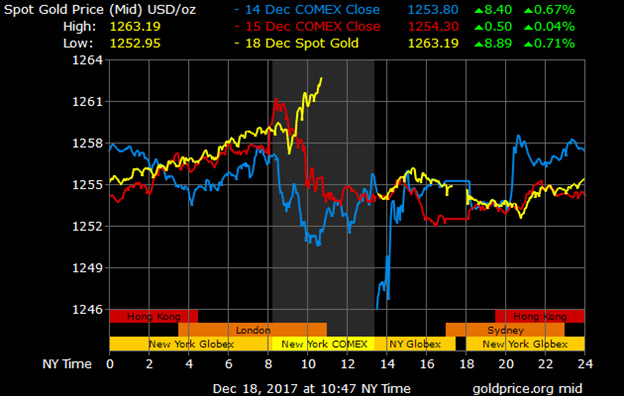At the start of 2017, there was tremendous interest in gold. The gold price was one of the most watched economic instruments in the world. However, the cryptocurrency boom in Q3 and Q4 was a gut-punch to gold, and speculators have diverted their attention to this virtual asset en masse. Consider that the market capitalization of digital currencies is approaching $600 billion, and while small compared to the market cap in gold, it is no longer insignificant.
Where Is Gold Headed?
This begs the question: Where to next for the precious metal? By late December 2017, gold was hovering around $1,263 per ounce. For the year to date, gold has averaged approximately 10.48%, holding steady in a tight trading range between $1,150 and $1,300. At times, the gold price threatened to break out above the $1,300 per ounce level, but it has been unable to sustain momentum.
Gold demand is driven by volatility, uncertainty, and fear. It comes as no surprise that the gold price remains depressed, given the performance of US indices. Consider the following statistics heading into 2018:
- The Russell 2000 has a year to date performance of 14.17%
- The NYSE Composite PR has a year to date performance of 14.86%
- The S&P Mid-Cap 400 has a year to date performance of 15.32%
- The S&P 500 TR has a year to date performance of 21.86%
- The Dow Jones Industrial Average has a year to date performance of 27.75%
- The NASDAQ Composite Index has a year to date performance of 28.86%
Gold under Pressure as US Indices Boom
Clearly, gold won’t prosper when US indices are averaging 21% + for the year. Given that gold is a fear-based commodity – every time indices come under pressure, traders and investors flock to gold for safe haven. The relatively modest performance of gold over 1 year is reflective of the strength of the performance of US indices. It is notable that the average return (percentage annual change) on gold prices in USD terms since 2002 is 11.1%. In the UK, the return is 12.1% over the same period.
While gold is certainly not booming, it is an inflation-beating commodity. It is worth pointing out that gold is negatively correlated to the strength of the USD. Since gold is a dollar-denominated asset, every time the USD appreciates, demand for gold decreases. Consider that in 2017, the Fed has implemented multiple rate hikes. Every time the Fed FOMC decides to raise the federal funds rate by 25-basis points, this adds a little downward pressure on to gold demand.
Hold Your Gold
The reason why gold is inversely correlated with the USD is clear: foreign buyers of gold are required to spend more per unit of their currency every time the USD appreciates when they buy gold. Therefore, less gold will be demanded when the USD is bullish. The performance of the greenback in 2017 has been rather subdued. However, various monetary and fiscal policies are likely to boost the strength of the USD in 2018. These include ongoing moves by the Fed to raise interest rates (currently in the 1.25% – 1.50% range), and fiscal policy.
If the House and Senate agree on a corporate tax cuts proposal to reduce the rate from 35% to 21%, this will be beneficial to the USD. If the greenback appreciates, this will make gold relatively more expensive to foreign buyers. Gold demand will drop, and US indices will likely benefit from higher stock prices through tax reform. Overall, Olsson Capital gold trader, Edwin Miles Sr believes that gold is a hold commodity with limited upside potential, barring geopolitical uncertainty.



 Bitcoin
Bitcoin  Ethereum
Ethereum  Tether
Tether  XRP
XRP  Solana
Solana  USDC
USDC  TRON
TRON  Lido Staked Ether
Lido Staked Ether  Cardano
Cardano  Avalanche
Avalanche  Toncoin
Toncoin